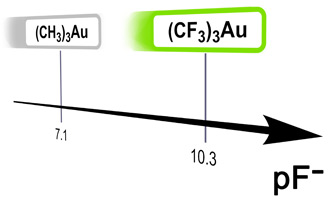
|
(CF3)3Au as a Highly Acidic Organogold(III) Fragment
Alberto Pérez-Bitrián, Miguel Baya, José M. Casas, Larry R. Falvello, Antonio Martín, Babil Menjón
Chem. Eur. J. 2017, 23, 14918-14930
DOI: 10.1002/chem.201703352
|
|
|
The Lewis acidity of perfluorinated trimethylgold (CF3)3Au was assessed by theoretical and experimental methods. It was found that the (CF3)3Au unit is much more acidic than its nonfluorinated analogue (CH3)3Au, and probably sets the upper limit of the acidity scale for neutral organogold(III) species R3Au. The significant acidity increase on fluorination is in line with the CF3 group being more electron-withdrawing than CH3. The solvate (CF3)3Au⋅OEt2 (1) is presented as a convenient synthon of the unsaturated, 14-electron species (CF3)3Au. Thus, the weakly coordinated ether molecule in 1 is readily replaced by a variety of neutral ligands (L) to afford a wide range of (CF3)3Au⋅L compounds, which were isolated and characterized. Most of these mononuclear compounds exhibit marked thermal stability. This enhanced stabilization can be rationalized in terms of substantially stronger [Au]−L interactions with the (CF3)3Au unit. An affinity scale of this single-site, highly acidic organogold(III) fragment was calculated by DFT methods and experimentally mapped for various neutral monodentate ligands. The high-energy profile calculated for the fluorotropic [Au]−CF3⇌F−[Au]←CF2 process makes this potential decomposition path unfavorable and adds to the general stabilization of the fragment
|
|

